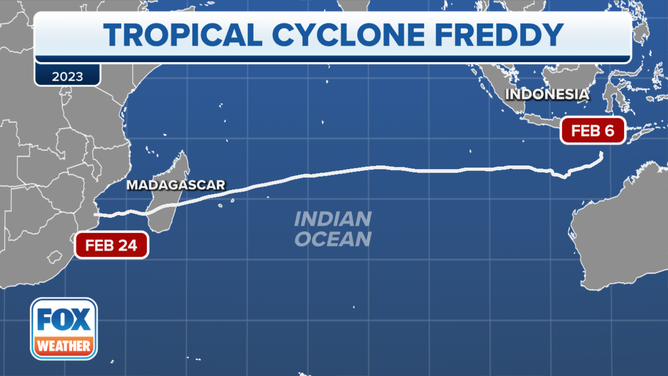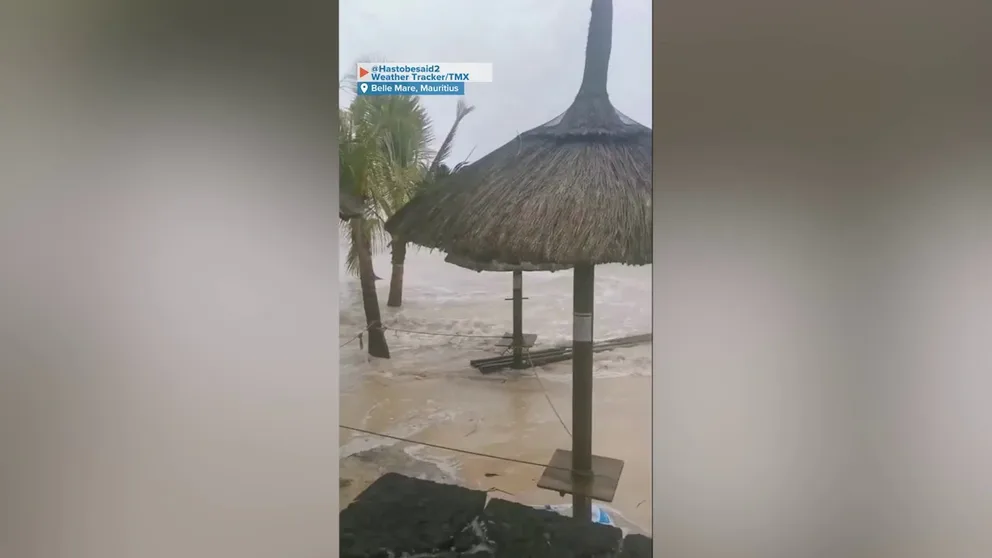Cyclone Freddy concludes unusual 5,000-mile, 19-day journey across Indian Ocean with rare Africa landfall
In terms of Accumulated Cyclone Energy, or ACE – an integrated metric that accounts for the frequency, intensity and duration of tropical cyclones – Freddy is now the all-time record holder for the Southern Hemisphere.
Waves, heavy rain from Cyclone Freddy near southern Africa
Waves and heavy rain from Cyclone Freddy took over beach shelters on the island of Mauritius on Monday. Freddy is expected to make landfall in Madagascar this week. (Credit: @Hastobesaid2/ Weather Tracker/TMX)
Cyclone Freddy traveled nearly 5,000 miles across the southern Indian Ocean – one of the longest tropical cyclone tracks on record in that ocean basin – and concluded its unusual 19-day journey as it made a rare landfall in southern Africa on Feb. 24.
While these types of storms are called tropical storms and hurricanes in the Atlantic and Eastern Pacific oceans, they are called cyclones in the Indian Ocean.
5 DIFFERENT NAMES FOR HURRICANES AROUND THE WORLD
Cyclone Freddy turned deadly in Madagascar
Cyclone Freddy made its first landfall near Mananjary on the eastern coast of Madagascar during the late-morning hours on Feb. 21 (U.S. time). A forecast advisory issued by the U.S. Joint Typhoon Warning Center (JTWC) about an hour before Freddy moved onshore indicated the tropical cyclone had maximum sustained winds of 115 mph, equivalent to a Category 3 hurricane on the Saffir-Simpson Hurricane Wind Scale.
According to the Associated Press, Cyclone Freddy was blamed for the deaths of four people in Madagascar. Freddy's torrential rain and powerful winds pummeled portions of the island nation, where nearly 5,000 homes were damaged and more than 16,000 people were left displaced, the AP reported.
Cyclone Freddy peaked at Category 5 intensity
Cyclone Freddy peaked at Category 5 hurricane-equivalent intensity during the weekend of Feb. 18-19 as it tracked across the southern Indian Ocean.
NOAA's historical hurricane tracks database indicated that Freddy was only the 20th tropical cyclone to reach Category 5 status in the South Indian Ocean since 1989. That's an average of approximately one Category 5 cyclone every two years in that ocean basin.

(FOX Weather)
Cyclone Freddy later made rare landfall in southern Africa
After moving across the island of Madagascar, Freddy emerged over the Mozambique Channel and continued to move westward toward Mozambique.
Cyclone Freddy then made its second landfall in the Mozambique coastal town of Vilanculos on the morning of Feb. 24 (U.S. time), with maximum sustained winds estimated at about 70 mph, according to the AP. That's equivalent in strength to a high-end tropical storm.
This landfall was quite rare because less than 5% of southern Indian Ocean tropical cyclones make landfall on the eastern coast of southern Africa, according to a study published in the journal Weather and Forecasting in October 2004.

(FOX Weather)
Torrential rain brought a flood danger to Mozambique, southern Africa
The World Meteorological Organization (WMO) said Cyclone Freddy dumped "dangerous and exceptional rainfall levels" in Mozambique and neighboring portions of southern Africa, including Zimbabwe and northeastern South Africa.
Torrential rain had threatened to bring dangerous flash flooding and landslides to those areas, especially in hilly or mountainous terrain.
"There is a potential risk that months' worth of rainfall may fall in the space of a few days, causing widespread flooding in an area which already has saturated soils and high river basin levels from unusually heavy seasonal rains," the WMO warned in a statement.
WATER FROM HURRICANES, TROPICAL STORMS KILLS MORE IN U.S. THAN WIND
Tropical Cyclone Freddy brings strong winds to Mauritius
Tropical Cyclone Freddy delivers intense wind and rain to the island of Mauritius as the storm barrels toward Madagascar. Swells higher than 20 feet have been reported near the island. (Credit: @mikaelbaden / WEATHER TRAKER /TMX)
Freddy was among the longest-lived tropical cyclones on record
The origins of Cyclone Freddy began on Feb. 6, when it developed off the coast of southern Indonesia. It then traveled across the entire southern Indian Ocean – a journey of nearly 5,000 miles – over a period of 19 days.
According to NOAA's historical hurricane tracks database, there has only been one other Category 1-equivalent or stronger tropical cyclone in the southern Indian Ocean to make the entire journey from near Indonesia all the way to Madagascar: Cyclone Eline/Leone in February 2000.

The nearly 5,000-mile-long journey of Cyclone Freddy across the southern Indian Ocean began off the coast of southern Indonesia on Feb. 6, 2023.
(FOX Weather)
In terms of Accumulated Cyclone Energy, or ACE – an integrated metric that accounts for the frequency, intensity and duration of tropical cyclones – Freddy is now the all-time record holder for the Southern Hemisphere.
According to Phil Klotzbach, a tropical weather expert at Colorado State University, Freddy surpassed the ACE of Cyclone Fantala in 2016, the previous Southern Hemisphere record holder.
Additionally, Cyclone Freddy generated the most ACE of any tropical cyclone on Earth since Hurricane/Typhoon Ioke in 2006, which was a long-lived and intense storm that tracked across the Central and Western Pacific Ocean, peaking at Category 5 intensity during its 17-day journey.
Freddy's ACE even surpassed that of Hurricane Irma in 2017, Klotzbach noted.
HOW MANY CATEGORY 5 HURRICANES HAVE MADE LANDFALL IN THE U.S.?
The only two Atlantic hurricanes with a higher lifetime ACE than Cyclone Freddy were Hurricane Three in 1899 and Hurricane Ivan in 2004.
Tracking Tropical Cyclone Freddy
Meteorologists are tracking one of the strongest cyclones of the year in the Indian Ocean. The cyclone was visible from International Space Station.


